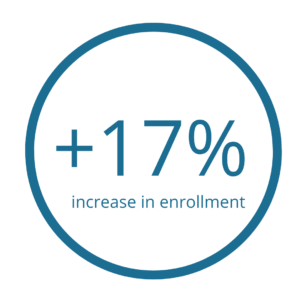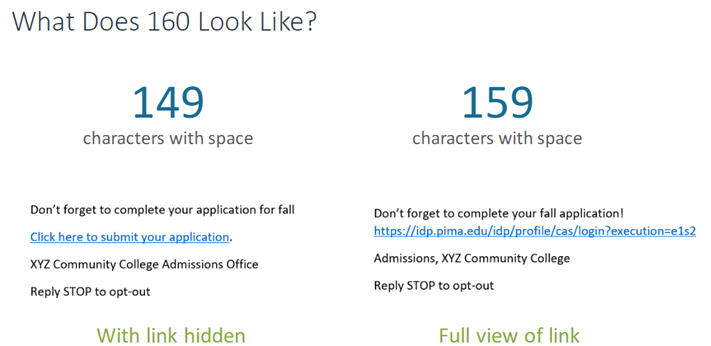
Stamats Insights
October 17, 2022
SMS text marketing is a largely unexplored opportunity for many colleges and universities across the U.S. This common communication tool from our everyday life has room to grow in higher ed recruitment. What is the most effective way to connect (or in some cases, reconnect) with target audiences to increase student enrollment?
Pima Community College in Arizona made great strides in their enrollment numbers for Fall 2021 by pivoting and sending strategic SMS text marketing reminders to reduce stopouts, which had increased nationally due to the pandemic. The focus audience for the campaign was stopout students.

In summer 2021, Pima reported an increase in enrollment by 17%, at a time when most colleges and universities in the U.S. were losing students—generating 308 re-enrollees in just five days and earning thousands of dollars in tuition. To date, their two text campaigns have totaled over $531,000 in potential ROI.
Texting is effective because of the inherited precision for sending a message—particularly shorter messaging, because you must consolidate and get right to the point. The specific audience segmenting that texting requires ensures you are speaking to the right students who need your message most. Everyone is checking their phones constantly, so messages sent via text rise to the top, as opposed to getting lost in a crowded email inbox.
You can increase enrollment by implementing SMS texting alongside your email marketing strategy. Finding your best audience and getting them to connect with you requires a two-fold approach.
First, you must focus on defining and refining your data to articulate the exact student segments on whom you want to focus your enrollment efforts. Then, you must write a focused message that resonates with your audience and drives them to action.
Follow these three tips to use data strategically and identify the perfect audience(s) for your messaging:
Long before a single message can be sent, culminate a set of data, and organize it to reach the precise audience, at the right time. The information you compile is only as valuable as the integrity of the data.
Make sure your data is correct. Spelling errors, outdated information, incomplete fields, duplicated records, etc., can throw off your marketing efforts from the onset by eroding student trust in your carefully curated messaging.
Review and clean your data periodically, ensuring it is accurate and relevant. To build a strong data foundation, we recommend you collect as many of these data points as possible:
Collecting these key data points and storing them in your customer relationship management (CRM) system provides a framework for you to focus your SMS messaging efforts to reach, recruit, and retain salient student segments. If you do not have a CRM, you can store data in an email platform, spreadsheet, or custom database such as Access or in the SISS.
Want a hand getting started? Email Marianne Sipe for help reviewing, streamlining, or updating your data collection process.
Remember your enrollment funnel. Data searches start wide—your entire CRM database—and then you filter values again and again, until you reach the specific audience needed for a message.
For instance, starting at the Student Stage allows you to collect all inquiries—potential students who raised their hands and asked for your school to send information.
However, you may want only students who are transfer students for this message.
Add an additional filter to find only students who are transfers. Focusing your search narrows the audience further. Next keep adding filters as needed, until you precisely reach the audience you are trying to target.
Eventually, you polish your list into a fine-tuned, customized audience. You are now ready to create tailored text messages.
Before you write any messages, make sure you have permission to send them. Following the rules and being courteous is crucial when sending text messages in large batches.
Partner with your legal department to ensure your marketing communications follow regulations applicable to your institution (i.e., CAN-SPAM Act, California Privacy Act, GDPR). Not following the rules can lead to legal claims or reputational harm.
For SMS campaigns, make sure you always:
Following these basic steps helps schools remain on the right track to following regulations for texting. Not following the rules can lead to more opt-outs, meaning your school can no longer communicate with the students.
Next, curate focused SMS messages that encourage your audiences to take the intended next steps.
Related reading: How Strategic Calls-to-Action Improve the User Experience and Marketing ROI
Follow these three best practices every time you create a tailored text message for your customized student segments:
Use simple language and focus on your main point. Keep every text message to 160 characters or less, including spaces. Any longer and it breaks into two or more messages.
The breaks can confuse or irritate the recipient. Sending lengthy text messages turns many recipients off and may lead them to opt out. Once that happens, your school can no longer reach or communicate with them through this channel.
When a system sends messages and breaks them into parcels during transit, additional costs accrue for your institution. If you only send 25 messages, this extra cost is insignificant. But if the batch of sends is more like 3,000, this steadily eats away at your communications budget.
Use a character count tool providing characters including spaces to check all message lengths.

While developing any communication plan, ask yourself if the message is about a crucial date or a crucial step. If the answer is no, it is better not to send it by text. Find a different avenue to send the message—and in some cases, don’t send it at all.
Some examples of appropriate reasons for SMS messaging include:
Consider the best time to send a message. For example, the first day of school is probably not the best time to send a reminder message. Sending reminders a week before classes start can be effective for community colleges.
Then, verify the message is pertinent for every person you plan to send it to. Imagine your messaging campaign is focused on getting stopouts to register for the upcoming semester. In that example, you would remove data points for and avoid sending the message to students who:
Sending an unnecessary or irrelevant message creates issues for the student and the college. This can lead to bad PR on social media as students post disgruntled commentary about the poorly sent text.
Less can be more. Exclude additional, irrelevant data points from your send list to create a clean and strategic audience for your specific call-to-action. Sending texts to the right people the first time helps you reach the intended goal of the message faster—and positions you for a win-win with the audience.
For example, Pima launched another stopout campaign in 2022. Over 30 days, they contacted nearly 13,000 stopout students and earned potential immediate revenue—plus ongoing potential revenue for subsequent semesters. In other words, they earned a return on investment for increased tuition for the institution from students who clicked a link in the message and registered for classes on the spot.
When you craft every message, ask yourself, “In an ideal world, what action will your student take with this message?” That is your end goal.
Messaging for stopouts is specific, with a small number of branches where the student can land to reach the goal. The goal of the college is for the stopout to register for class. Carefully design your messaging to clarify where a student currently is in the process.
Set the flow of the messaging to find out if the students are:
The response places students into the appropriate audience bucket to share with your internal staff tasked with helping students. This conserves resources, encourages enrollment, and sets a school up for success.
With each campaign you send, you will gain valuable insights to help you hone your student segments further and fine-tune your messaging based off previous efforts. Consistent, versatile strategies are important to any marketing plan.
Consider including SMS text marketing into your multi-channel digital marketing strategy. It can help you get in front of the right students, at the right time.
We’d love to help you develop your strategy, build a communication plan, or optimize your enrollment campaign. Connect with Marianne Sipe to learn more about accelerating your enrollment growth.
Ready to Get Started?
Reach out to us to talk about your strategy and goals.